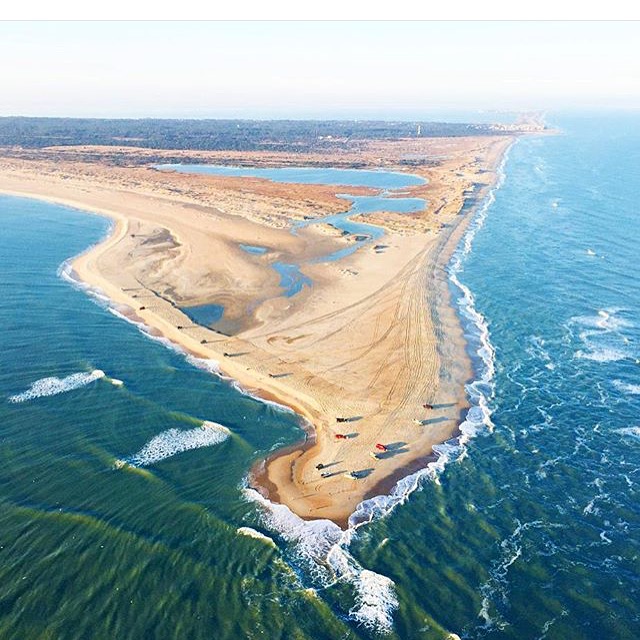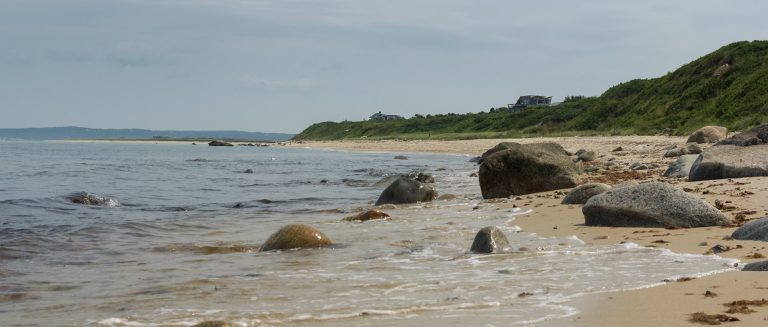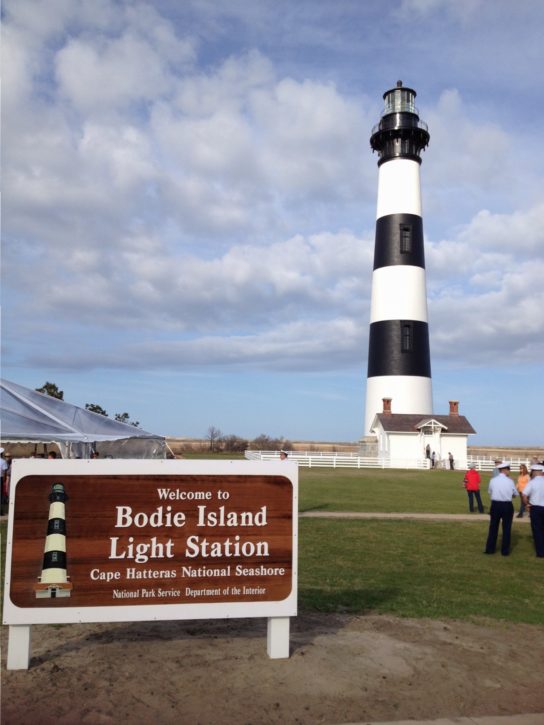Much like the Outer Banks, Martha’s Vineyard is made up of small towns and villages, many of them with histories that extend as far into the American past as the towns of the Outer Banks.
And like the Outer Banks, Martha’s Vineyard has a rich maritime history.
Because Martha’s Vineyard, along with nearby Nantucket, were important seaports at one time, lighthouses dot the coast of the island. There are five of them on the island, although none of them are as tall as the Outer Banks lighthouses. Tours are available for some of the lighthouses although climbing is somewhat restricted.
An important difference, though, between the Outer Banks and Martha’s Vineyard is the nature of the islands.

The Outer Banks is a barrier island, a thin ribbon of sand facing the sea. Martha’s Vineyard is a true island, permanently affixed to its location between the Atlantic Ocean and Cape Cod.

Most of those differences aren’t all that important in comparing tourist destinations. As an example, there are farms on Martha’s Vineyard. Outer Banks’ families historically were subsistence farmers but the sandy soil of the barrier island would never support a profitable farm.
The Beach Experience
Where it does make a difference is in the shoreline and beaches.
Outer Banks beaches are soft expanses of sand. There are, of course, some differences in the sand; Kitty Hawk, as an example, has coarser sand than either Corolla or Nags Head. What they all offer, because really what they are is a continuous ribbon of sand, is plenty of room to spread out.

Although for the most part, Martha’s Vineyard beaches are comparable in the quality of sand, there is not as much beach available, and in the summer people tend to be really packed in.
Some of that is geography, but contributing significantly to why there is not as much beach available to the public are the legal differences in how Massachusetts and North Carolina view their shorelines.
Along the Outer Banks, except for protected areas and inlets, the beach is open to anyone.
That is not the case on Martha’s Vineyard.

North Carolina beaches are in the public domain, meaning there is no private ownership of any of the state’s beaches. With a set of good strong legs and a lot of time, it is possible to walk from Coquina Beach in South Nags Head to the Virginia State line and never step on private property.
Massachusetts permits private ownership of its beaches and there are private beaches on Martha’s Vineyard. Public beaches as well, of course, but there are beaches on the island where use is restricted to a particular group or sometimes the residents of a town.
The Weather
Another significant difference between the Outer Banks and Martha’s Vineyard is the weather. The Vineyard is a little drier than the Outer Banks, but the real difference is daytime temperatures from month to month and ocean temperatures.
Here on the Outer Banks, people have really come to appreciate our shoulder seasons—especially May and September. Daytime temperatures are pleasant—actually quite warm in September. Ocean temperatures in September are marvelous; a bit brisk in May—the average is 62 degrees—but it does warm toward the end of the month.

The weather on Martha’s Vineyard makes it very much a three, maybe three and a half month destination for anyone who enjoys sitting on the beach and jumping in the water. The average water temperature in May is 50 degrees; the average daytime high is 63, about 12 degrees cooler than the Outer Banks. Although air temperature in June is beginning to warm, the water temperature is still struggling to get to 60 degrees.

On the Outer Banks, October has become our unofficial festival month with major festivals dotting the calendar including the Duck Jazz Festival and the Outer Banks Seafood Festival. There is, of course, no guarantee when it comes to weather, but over the years we’ve come to expect daytime highs in the 70s for those gatherings, and as evening comes on, temperatures remain comfortable if cool.

By the time October rolls around the differences between a New England and North Carolina climate are becoming more apparent. Daytime highs in October average eight to ten degrees colder than the Outer Banks, and after the sun sets, evening temperatures in New England regularly dip into the 40s.
The Nature of Things
Keeping nature close at hand is one area where the Outer Banks and Martha’s Vineyard are comparable. The Manuel F. Correllus State Forest is a very large state forest that occupies the middle of the island. It is one of a number of protected areas on the island.
Although there is not as much room for kiteboarding on the Island as there is on the Outer Banks, Martha’s Vineyard does have comparable winds and so the sport thrives in both places. It’s certainly warmer on the Outer Banks with warmer water temperatures, but both locations have good winds.

The south-facing beaches of the island do get some good waves for surfers, but there is no doubt that the Outer Banks consistently has better conditions.
Getting There and Staying There
Over the years, Martha’s Vineyard has become known as the vacation mecca for the rich and famous. Presidents have been known to vacation there; business tycoons, authors, and actors—all of them have contributed to the island’s fabled history.
The rich and famous as part of the tourist population is greatly exaggerated. Certainly, there are wealthy people vacationing on Martha’s Vineyard, but like the Outer Banks, most of the visitors don’t quite fall into that category.
But there is no doubt that just getting to the island is a costly endeavor.

Unlike North Carolina where ferry service from Hatteras to Ocracoke is free, the state of Massachusetts charges for passage from Cape Cod to Martha’s Vineyard. The fee schedule changes depending on the size of the car, but most cars will have to pay $130 for a 45 minute round trip.

North Carolina does charge for a ferry ride from Swan Quarter or Cedar Island to Ocracoke, but even those fares are considerably cheaper than the Massachusetts fares. The three hour trip from Ocracoke to either Swan Quarter or Cedar Island costs $30 for a round trip.
There is also scheduled air service through Cape Air, a regional carrier that operates from Boston, Hyannis, and other locations. Airfares are considerably more expensive than taking a ferry.
